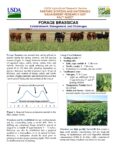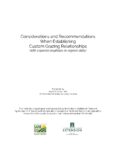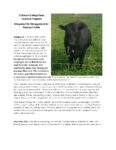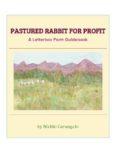The educational materials listed on this page are about Grazing Management.
Grazing management is critical to any pasture-based livestock farming system. Rotational grazing, intensive rotational grazing and management intensive grazing are key to successful and sustainable rotational grazing systems. So, what is rotational grazing? Careful grazing strategies include stocking rates of cattle, time spent on each paddock or pasture, how many times a herd revisits that same paddock or pasture throughout the year, and incorporating multi-species grazing to reduce parasite loads. Management approaches used to increase grazing uniformity, such as water sources and fencing, improve livestock grazing distribution problems. Rotational grazing cattle may also require capital expenditures. Thus, less expensive, practical solutions, like selecting cattle with desirable grazing patterns and culling cattle without, have been suggested as tools for improving managed intensive rotational grazing. This makes a rotational grazing definition difficult to refine depending on geographic location. Key practices include holistic management, grazing management, rotational grazing, livestock breeding, stocking rate, rangeland pasture management, pasture renovation, watering systems, multi-species grazing, continuous grazing.
The Rangeland Management Strategies bulletin has information for multi-species grazing and winter grazing, and it offers advice for forage management and vegetation management, as well as practices for protecting riparian areas. SARE’s Small Ruminant Toolbox offers producers with small ruminant livestock enterprises practices that provide pest, weed and parasite control. Smart Water Use on your Farm or Ranch can be used to better understand the role of water in a farm system and in grazing management.
Showing 1-5 of 5 results
How Alive is My Soil?
This guide presents soil testing methods that can be performed in the field by farmers, gardeners, or anyone who desires to understand and appreciate soil from a different perspective. While these tests aren’t intended to be a replacement for sending soil to a lab, they can be considered complementary to annual or biannual lab analysis.

Forage Brassicas
Forage Brassicas are annual crops that can grazed during the spring, summer and fall to extend the grazing season. This fact sheet provides an overview to establish and graze kale, rape, radish, swede and turnip.

Considerations and Recommendations When Establishing Custom Grazing Relationships
This guide and set of recommendations are intended for organic dairy farmers and other livestock graziers interested in starting a custom grazing relationship with a neighboring farmer or landowner. Successful custom grazing can provide or increase grazing acreage for those farmers who need it and can also provide opportunities for smaller, beginning, leased, and diversified […]

Integrated Fly Management for Pastured Cattle
In grazing systems, flies can not only be a nuisance for cattle but can also cause herd health problems like pink eye, and reduce milk production and weight gain. Matt Steiman, livestock manager at Dickinson College Farm worked with Dr. Jason Smith, entomologist and horticultural specialist at Milton Hershey School to develop this fact sheet […]

Pastured Rabbit for Profit
Pastured Rabbit for Profit is a guide written by New York farmer Nichki Carangelo. It is a practical resource intended to guide farmers through the start-up phase of a pasture-based rabbitry. It includes a full enterprise budget along with housing plans, sample breeding schedules, feed guidelines and other rabbit husbandry basics. Chapters include: